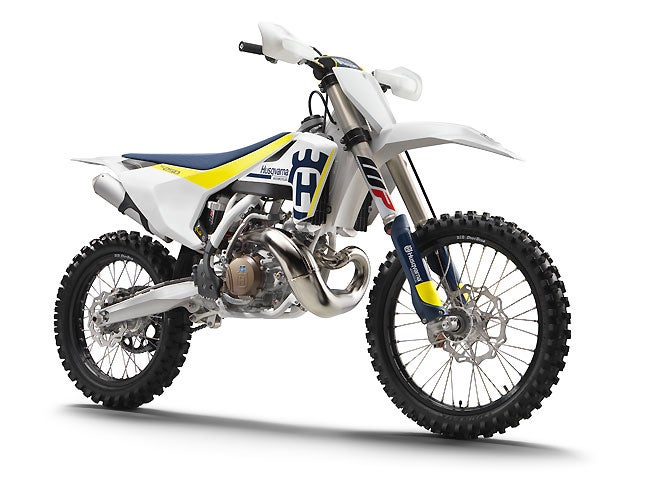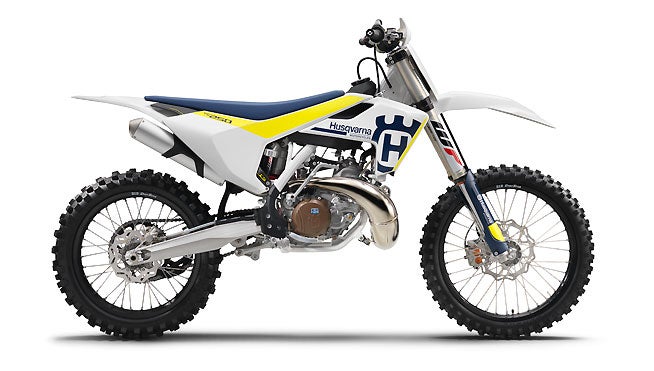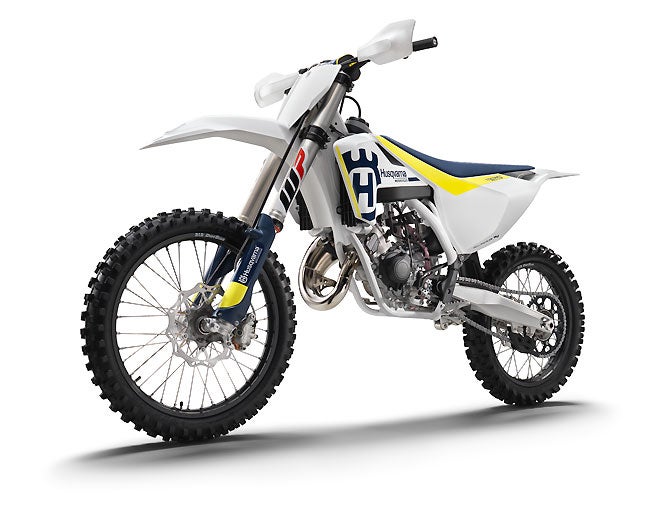Husqvarna joins the air fork brigade for 2017; TC 250 two-stroke receives an all-new engine.

Husqvarna announced today its 2017 line of two-stroke and four-stroke motocross machines, and while no new models have been added to the lineup, the Husqvarna TC250 features an all-new engine, and the rest of the 2017s feature significant upgrades, particularly in the suspension department.
For 2017, Husqvarna joins the air fork movement in motocross with the introduction of the WP AER 48 fork. The 48 mm split air fork design incorporates an insulated air spring and pressurized oil chamber designed to provide what Husqvarna calls progressive and consistent damping. The fork also features new outer fork tubes designed to increase flex for a better feel on the track. The AER 48 weighs 3.7 pounds less than the WP 4CS coil spring fork that it replaces. Out back, a WP DCC shock is suspended via a rising-rate linkage. Suspension travel is 11.8 inches front and rear.
Tuning the AER 48 is accomplished via a single air pressure valve for preload (on the left leg) as well as easy access clickers adjusting damping via 30-click range (on the right leg). Unlike some of its competition, Husqvarna will supply the air pump needed to adjust the fork’s air pressure at the time of purchase.
Also new for 2017 is a traction-control feature that has been added to the EMS Map switch and launch control on the FC four-stroke models. In addition to allowing the rider to choose between two different engine maps, the handlebar-mounted map switch also operates a traction control feature completely new for 2017. This can be selected to an on or off position from the switch and functions that analyzes throttle input from the rider and the rate at which RPM increases in the engine. If the RPM increases too quickly, the EMS will register a loss of grip and reduce the amount of power to the rear wheel ensuring maximum traction, which Husqvarna says can be a distinct advantage in wet or muddy conditions.
2017 Husqvarna TC 250

The TC 250 boasts an all-new two-stroke engine with a new 66.4mm bore and a new power valve system designed to deliver a smooth and controlled power throughout the RPM range. The power valve tuning altered by simply changing two springs to tailor the power delivery for track conditions and/or rider preference. A new cylinder and cylinder head incorporate a new water jacket design for better cooling, and cylinder head mountings are incorporated for vibration reduction. The TC 250 also gets a new piston with an optimized shape; the diameter of the piston crown has been increased for increased stability and reliability.
The TC 250’s engine cases are also new, designed to improve mass centralization. The lightweight, die-cast cases place the clutch shaft is 4mm higher while the crankshaft position is 19.5 mm higher to centralize oscillating mass The counter balancer shaft is more compact than the previous design. The TC 250’s crankshaft features the same 72mm stroke as the previous generation, but the balance has been changed to work with the new counter balancer to reduce engine vibration. New engine covers offer better resistance from wear created by riders boots.
Fueling is handled via a new 38mm flat slide Mikuni TMX carburetor, which replaces the previous Keihin model. Husqvarna says that the TMX helps to provide smoother, more controllable power delivery with optimal performance over the entire RPM range. Additionally, it is also easier to tune for atmospheric conditions.
The TC 250’s new five-speed gearbox features the same gear ratios as the previous generation, but a revised shift mechanism design is said to deliver easier and more precise and shifting. Husqvarna also redesigned the shift lever to reduce dirt build-up. The TC 250 uses Husqvarna’s DDS (Damped Diaphragm Steel) clutch, which features a diaphragm spring instead of the more common coil spring design to allow for a much lighter clutch action. This design also incorporates a damping system to increase traction and offer better durability.
Husqvarna also had WP design a new exhaust pipe for the TC 250. The pipe is constructed via a three-dimensional stamping process. After the elements of the exhaust have been shaped it is robotically welded to ensure durability.
2017 Husqvarna TC 125

The 2017 TC 125 benefits from some of the development that went into the TC 250 as well as the rest of the Husqvarna motocross family. Husky’s screaming eighth-liter two-stroke also receives the WP AER 48 fork as well as a new carburetor.
Producing a claimed 40 horsepower in an engine that weighs just 38 pounds, the TC 125 features a 54mm bore with a Teflon-coated piston. Husqvarna engineers revised the TC 125’s cylinder for better cooling, and its power valve is also updated in search of better engine performance. The 2017 TC 125 now features a 38mm flat slide Mikuni TMX carburetor, replacing the previous Keihin model for the same reasons as the TC 250—namely smoother, more controllable power delivery and easier tuning. Power is transferred through a Magura hydraulic-activated clutch and six-speed gearbox.
 Your Privacy Choices
Your Privacy Choices